“I have a British background and I have always had tea and something sweet. First time I tried this clotted cream I almost ate the entire jar by itself, it is that good!” ~Kim

If you’ve never had a classic English afternoon tea with scones and clotted cream, you’re missing out!
Last week I was treated by the historic Biltmore Hotel in downtown Los Angeles to their classic English afternoon tea. If you’ve never had a classic afternoon tea, you need to experience it. The highlight of any afternoon tea, besides the tea, is the array of tiny treats that comes with it, and I always zero right in on the scones and clotted cream. (That’s them on level two of our 3 tiered tea tray.)

What is Clotted cream?
If you’ve never had it, clotted cream is a very thick rich spreadable form of heavy cream that was first invented ages ago by some very smart British farmers. Traditionally cream heated until it thickens and develops a slightly nutty flavor. Clotted cream has a high fat content (around 55-65%) and a dense texture. It’s not like whipped cream, or cream cheese, it’s not like butter…it has a unique decadent consistency and a wonderful soft flavor. It’s quite thick and spreadable, and when you slather it on a freshly baked scone there is no better thing in the world.
The little pot of clotted cream that we got at the Biltmore had me craving more, and happily I made the most astounding discovery…you can actually make clotted cream at home in your own kitchen. No more tracking it down in specialty stores and paying big bucks for the imported stuff. My homemade clotted cream was actually way better (and a whole lot fresher) than the British stuff I usually buy.

What does clotted cream taste like?
Clotted cream has a rich, creamy taste with a slightly nutty ‘cooked’ flavor. It’s luxurious and indulgent, with a dense, velvety texture that is thicker and creamier than regular whipped cream. Clotted cream is also slightly sweet, but not as sweet as whipped cream or frosting, with a delicate flavor that pairs well with desserts, fruit, and scones. The crust on top of the clotted cream adds a slightly caramelized and nutty flavor, which many people find particularly delicious. The mouthfeel of clotted cream is a key part of its charm, and is like nothing else you’ve ever had!
what you’ll need
- heavy or whipping cream that has not been ultra-pasteurized
- This is cream that has been pasteurized, but not ultra-pasteurized. Ultra-pasteurized cream is cream that has been heated to a higher temperature than regular pasteurized cream to extend its shelf life.

How to make clotted cream
This is an amazing process, I hardly had to do anything, and I end up with a ton of the richest, silkiest clotted cream I’ve ever had.
- I used 2 pints of (non-ultra-pasteurized) heavy cream.
- I poured them into a baking dish, and left it overnight in a 180F oven (the lowest my oven will go.)
- In the morning I let it cool and then refrigerated it for the rest of the day.
- Then I scooped it into jars, which was a little sloppy at first, and put them back in the refrigerator. Any little bit of liquid gets absorbed right into the clotted cream after you put it in the jars, and by the next morning when I had it with my scones, it was absolutely to die for.
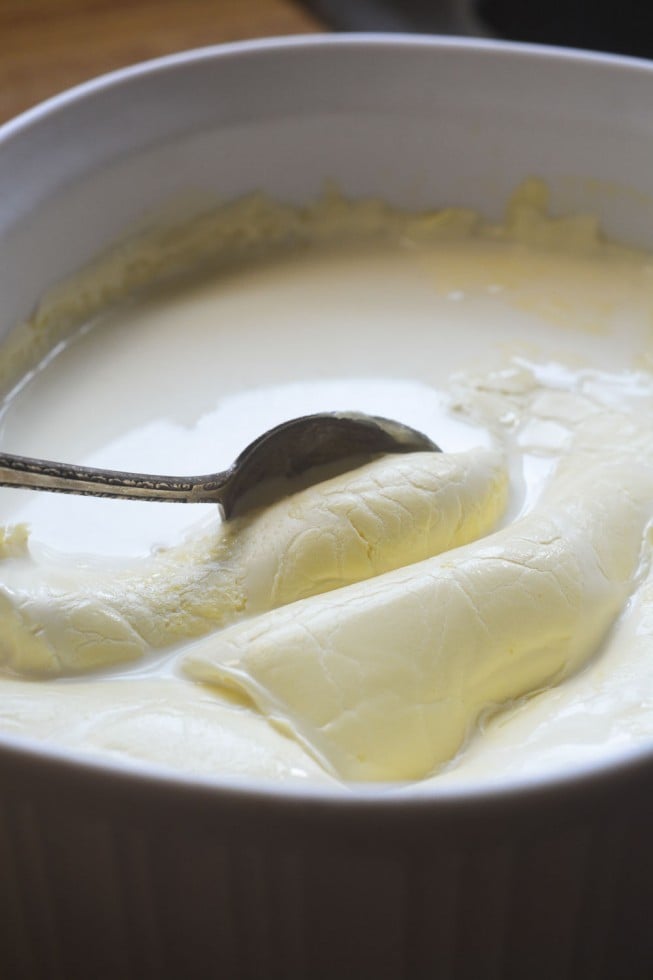
How long does clotted cream last?
Homemade clotted cream can last for up to 3-4 days when stored properly in the refrigerator. To extend its shelf life, it’s important to keep it in an airtight container and store it in the coldest part of the refrigerator, such as the back of the bottom shelf.
It’s important to note that clotted cream does not have any preservatives, so it should be consumed as soon as possible for the best flavor and texture. If you notice any changes in color, texture, or odor, discard the clotted cream immediately as it may have spoiled.
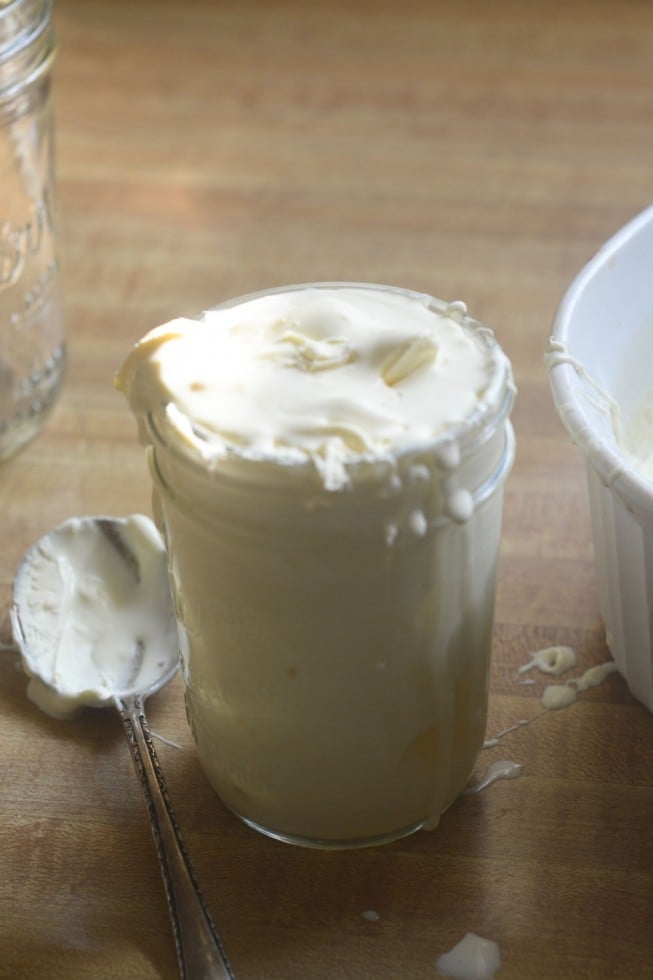
What to do with the leftover whey from making clotted cream
The leftover whey from making clotted cream can be used in a variety of ways:
- Adding it to smoothies or protein shakes for a boost of protein and nutrients.
- Using it as a substitute for milk or water in baking recipes such as bread, muffins, and pancakes.
- Using it as a marinade for meat or fish to tenderize and add flavor.
- Adding it to soups or stews for added richness and flavor.
- Using it as a liquid base for making homemade ricotta cheese or other soft cheeses.
- Feeding it to pets, as it is a good source of protein and nutrients for animals.
Note: It’s important to keep in mind that the leftover whey should be used or stored promptly to avoid spoilage. It can be stored in the refrigerator for up to a week or frozen for longer storage.
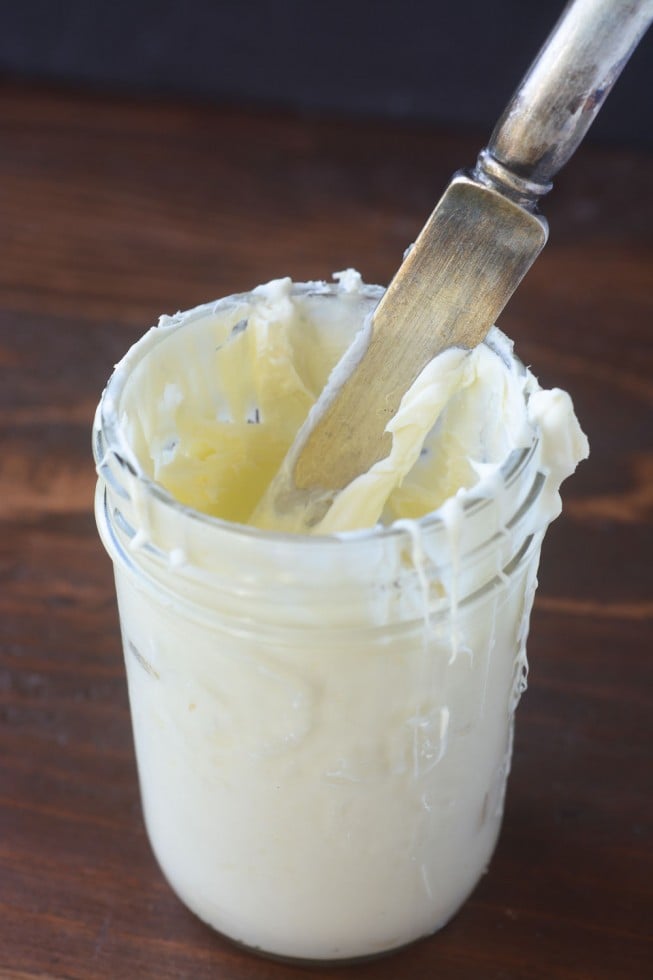
I can’t say enough good things about this project, the results far exceeded my expectations and it was absurdly easy. The only catch is that you can’t use ultra-pasteurized cream, which is cream that’s been processed for a longer shelf life. Many stores only sell ultra-pasteurized cream, so you have to search a bit for regular cream. I found mine at Whole Foods. Just read the labels… if it doesn’t say ultra-pasteurized on the label, you’re good to go.
can you make clotted cream with ultra-pasteurized cream?
Some readers in the comments below have had success with ultra-pasteurized cream. It is possible to make clotted cream from ultra-pasteurized cream, but it may be more difficult to achieve the desired texture and flavor. Ultra-pasteurization is a process that heats the cream to a higher temperature than regular pasteurization, which extends its shelf life but can also alter the proteins and enzymes in the cream. This can make it more difficult for the cream to form clots, which are necessary for making clotted cream.

What to eat with your homemade clotted cream
You will definitely want to make scones to go with your homemade clotted cream. I have lots of recipes for scones on the blog, but a simple one to start with is my Classic Cream Scones Recipe.
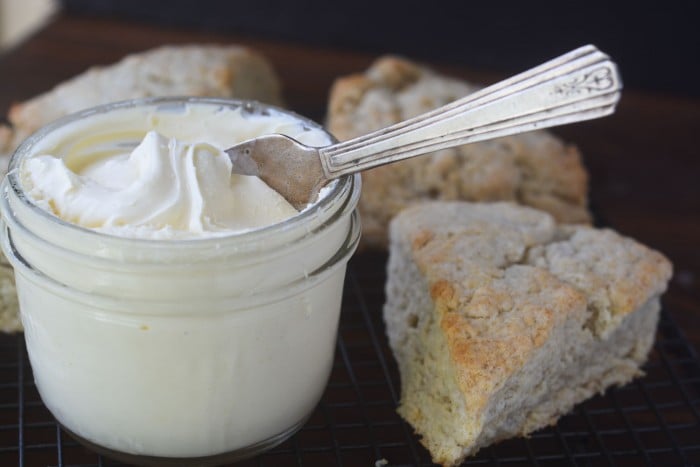
Tips for making clotted cream
- Make sure your cream is not ‘ultra pasteurized’, you will need to find regular pasteurized cream at a Whole Foods or other similar store. Ultra pasteurized cream has been treated in a way that prevents it from ‘clotting’.
- An oven thermometer is an essential kitchen tool, and really comes in handy for this project. If your oven is too cool or too hot your homemade clotted cream will not ‘clot’. Set your oven to 180F and then check the thermometer. You can adjust up or down as necessary.
- If your oven does not go down as low as 180F you can try one of my other methods for making clotted cream:

Homemade Clotted Cream
Video
Equipment
- a heavy casserole dish
Ingredients
- 2 pints heavy cream or whipping cream (double cream in the UK), avoid ultra-pasteurized cream for best results.
Instructions
- set your oven to 180F
- Pour the cream into the casserole dish. It should come up about 1-3 inches on the side.
- Set the dish, uncovered, in the oven and leave undisturbed for 12 hours. Be sure to leave the oven on the whole time. I do this overnight.
- Remove the dish from the oven and set to cool. Then cover and refrigerate. Note: the cream may seem thin at this point, but is going to thicken considerably overnight.
- The next morning scoop the thickened cream into a jar or jars, and cover and put back in the refrigerator. You can use the leftover cream for baking..
- Spread the clotted cream on freshly baked scones.
Nutrition


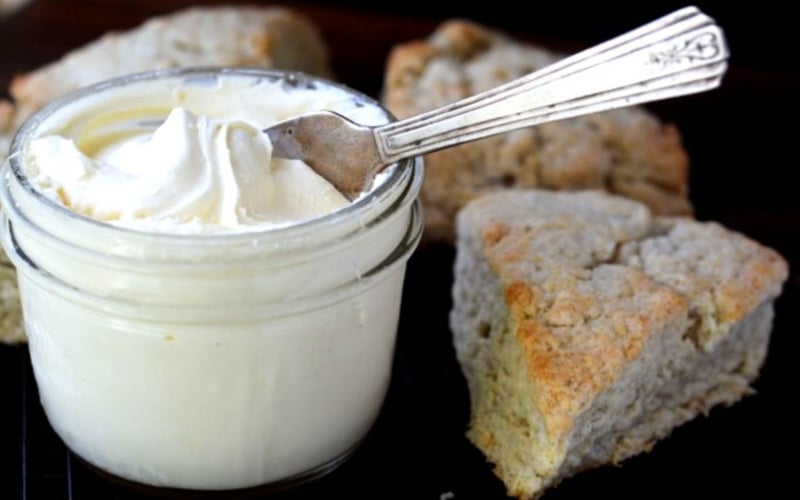












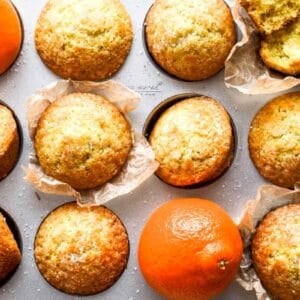







i just found your blog on Pinterest, and I am so enjoying everything!! I was wondering if you left the oven at 180 degrees or bring it up to then turn it off? I can’t wait to try the clotted cream with the cardamom scones!
You leave it on the whole time, Lila, I’ll edit the recipe to make it clearer, thanks!
I love Los Angeles for all it’s diversity! Tripe tacos for breakfast and clotted cream with high tea in the afternoon. GREG
Never had a tripe taco, but I’ll take your word for it Greg 🙂
You da man Greg! Love that your palate is so adventurous cuz tripe tacos to die for…we grew up on them! Joao
So oddly enough my oven starts at 175°, then goes up to 200° do I need to make any changes to the amount of time I cook it for, if I leave it at 175° thank you!
I would try at 175F Teri. That should be ok.
Oh my, how I miss proper Clotted Cream! I spent a good deal of my youth living in Devon and cream teas were one of my faves. Must try this recipe.
Wow, you’ll have to report back Linda…I’m not an expert like you, but I’ve had my share of clotted cream, and I think this is great.
OMG, I am drooling over that clotted cream! My cousin sent me a postcard from England with this recipe on it years ago and why I still have never made is beyond me! This looks absolutely brilliant, Sue.
It was so much fun to go to the Biltmore with you and Cynthia, and I hope we can do it again soon!
I am seriously blown away by the texture of this stuff…you need to make it asap!
Oh my! Who knew??? Clotted cream sounds so decedent and like butter only better! The scones look pretty fantastic too – a perfect combination! We love the Biltmore (in Ashville, NC). An amazing era. Your photos of the afternoon tea are wonderful!
I can just imagine tea at the Ashville Biltmore…I still haven’t been to see it but I hear it’s incredible, it’s going on my 2015 bucket list!
So jealous of your tea! It looks absolutely regal. And that clotted cream looks insane. I just made homemade butter, and it definitely won’t be the last time I do!
I think it’s fascinating that butter and clotted cream are essentially the same thing, but with such different tastes and textures!
What a lovely tea! I make scones for my family and whenever we have them, I start speaking in my fake British accent and saying things about clotted cream. : ) So I am so happy to learn how it’s actually made. Thank you!! Looks perfect.
Haha! I have bought the expensive little jars from Britain when i really wanted to get fancy, but this homemade version makes so much sense, I mean how good can anything made with fresh cream be in a jar?
The Biltmore .well looks positively superb.
My husband is a fan of cream..sour..clotted..all kinds..Good to know..Thanks!
Let me know how it works for you Monique.
The clotted cream looks wonderful! I’ve always loved it but have never thought to try making it from scratch. And I’m so excited (and flattered) that you made and enjoyed my scones!!! Thank you 🙂
I LOVED your scones, I may have to alter my basic recipe 🙂
i am having trouble finding heavy cream , is it the same as whipping cream?
Yes, you can use either, Helen, but you need to look for cream that is NOT ultra-pasteurized.
I adore going to tea and I imagine that the Biltmore is just about as lovely that it gets for that kind of experience. What a fun afternoon!!
It’s kind of hard to live that afternoon down, but the homemade clotted cream helps…thanks for stopping by Mary.
It seems Organic Valley is about the only one who makes pasteurized Heavy Cream, but I am not able to find it in the Whole Food stores in Los Angeles area. Would you let me know what brand you use and where do you get that from?
Thank You
Years ago, before taking an exam, our class was told to read each of the 50 question to the end before beginning to take the test. At the end of the test the directions stated, “Do only the first 20 questions, then put your pens down.” Those non-direction followers looked panicked when, one by one, students began putting their pens down. Clotted Cream … This was the longest response to a blog I have ever read. Many of the questions were repeated over and over again; how frustrating! The directions were clear from the beginning. Please, fellow foodies, read the directions. Follow “Mis en place.” Then reread the directions. Who knew the subject of clotted cream could evoke such passion amongst people. Hmmm. Think I’ll go in search of some non-ultra pasteurized cream!
I continue to love your site, Sue. Besides being a great cook, you are one patient lady! Best regards….
Susan
🙂 Go get that cream, you’re gonna love this!